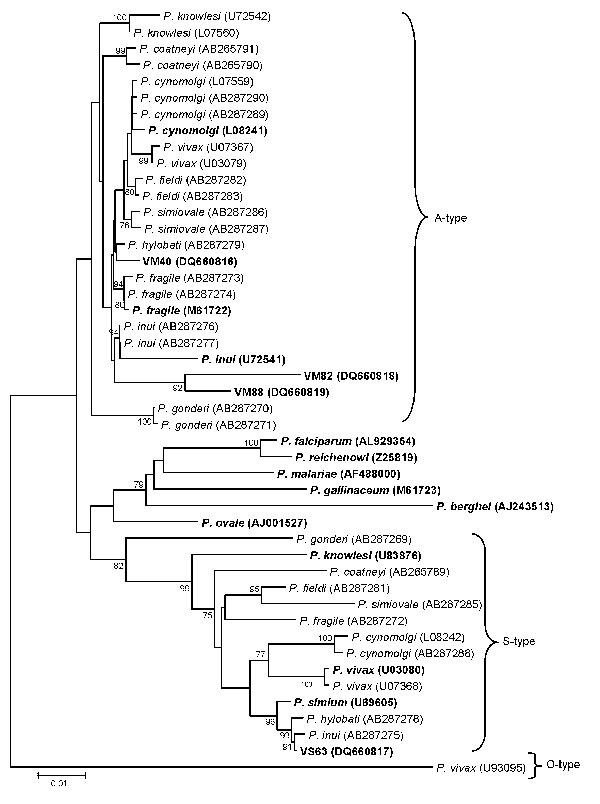Volume 15, Number 10—October 2009
Dispatch
Orangutans Not Infected with Plasmodium vivax or P. cynomolgi, Indonesia
Figure

Figure. Phylogenetic relationship of Plasmodium spp. inferred from small subunit ribosomal RNA sequences. Tree was reconstructed by using the neighbor-joining method. Boldface indicates those sequences derived from orangutans (VM40, VM82, VM88, and VS63) and those used by Reid et al. (12) in their phylogenetic analysis. Numerals on the branches are bootstrap percentages based on 1,000 replicates; only those >70% are shown. GenBank accession numbers are in brackets. Scale bar indicates nucleotide substitutions per site.
References
- Garnham PCC. Malaria parasites and other haemosporidia. Oxford (UK): Blackwell Scientific Publications; 1966.
- Garnham PCC, Rajapaksa N, Peters W, Killick-Kendrick R. Malaria parasites of the orang-utan (Pongo pygmaeus). Ann Trop Med Parasitol. 1972;66:287–94.PubMedGoogle Scholar
- Singh B, Lee KS, Matusop A, Radhakrishnan A, Shamsul SSG, Cox-Singh J, A large focus of naturally acquired Plasmodium knowlesi infections in human beings. Lancet. 2004;363:1017–24. DOIPubMedGoogle Scholar
- Jongwutiwes S, Putaporntip C, Iwasaki T, Sata T, Kanbara H. Naturally acquired Plasmodium knowlesi malaria in human, Thailand. Emerg Infect Dis. 2004;10:2211–3.PubMedGoogle Scholar
- Zhu H, Li J, Zheng H. Human natural infection of Plasmodium knowlesi [in Chinese]. Chinese Journal of Parasitology and Parasitic Diseases. 2006;24:70–1.PubMedGoogle Scholar
- Luchavez J, Espino F, Curameng P, Espina R, Bell D, Chiodini P, Human infections with Plasmodium knowlesi, the Philippines. Emerg Infect Dis. 2008;14:811–3. DOIPubMedGoogle Scholar
- Ng OT, Ooi EE, Lee CC, Lee PJ, Ng LC, Pei SW, Naturally acquired human Plasmodium knowlesi infection, Singapore. Emerg Infect Dis. 2008;14:814–6. DOIPubMedGoogle Scholar
- Cox-Singh J, Davis TEM, Lee KS, Shamsul SSG, Matusop A, Ratnam S, Plasmodium knowlesi malaria in humans is widely distributed and potentially life threatening. Clin Infect Dis. 2008;46:165–71. DOIPubMedGoogle Scholar
- Rogers MJ, Li J, McCutchan F. The Plasmodium rRNA genes: developmental regulation and drug target. In: Sherman IW, editor. Malaria: parasite biology, pathogenesis and protection. Washington: American Society for Microbiology; 1998. p. 203–17.
- Li J, Gutell RR, Damberger SH, Wirtz RA, Kissinger JC, Rogers MJ, Regulation and trafficking of three distinct 18 S ribosomal RNAs during development of the malaria parasite. J Mol Biol. 1997;269:203–13. DOIPubMedGoogle Scholar
- Nishimoto Y, Arisue N, Kawai S, Escalante AA, Horii T, Tanabe K, Evolution and phylogeny of the heterogeneous cytosolic SSU rRNA genes in the genus Plasmodium. Mol Phylogenet Evol. 2008;47:45–53. DOIPubMedGoogle Scholar
- Reid MJ, Ursic R, Cooper D, Nazzari H, Griffiths M, Galdikas BM, Transmission of human and macaque Plasmodium spp. to ex-captive orangutans in Kalimantan, Indonesia. Emerg Infect Dis. 2006;12:1902–8.PubMedGoogle Scholar
Page created: December 08, 2010
Page updated: December 08, 2010
Page reviewed: December 08, 2010
The conclusions, findings, and opinions expressed by authors contributing to this journal do not necessarily reflect the official position of the U.S. Department of Health and Human Services, the Public Health Service, the Centers for Disease Control and Prevention, or the authors' affiliated institutions. Use of trade names is for identification only and does not imply endorsement by any of the groups named above.